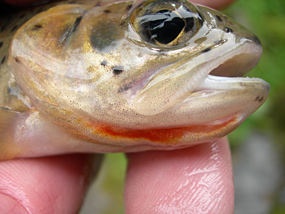 |
 | |
  | |
|
|
|
|
Yellowstone National Park
Attention Anglers: Know Your Fish, If it has a Slash, Put it Back!
|
|
|
|
|
|
 |
 |
| Photo by Zac Sexton | | Juvenile cutthroat trout |
 |
The fishing map within the Fishing Regulations indicates known locations of fish species within the boundaries of Yellowstone National Park. This handbook includes descriptions and identification tips for both native and nonnative sportfish. In Yellowstone, anglers are required to return all native fish back to the water immediately.
The native fish which MUST BE RELEASED UNHARMED include:
- Arctic grayling
- cutthroat trout
- mountain whitefish
|
 |
| NPS Photo/Todd Koel | | Close up image of red jaw slash on juvenile cutthroat trout. |
 |
Harvest of nonnative trout is allowed, and in some cases required, in many park waters. Please check the Fishing Regulations for details. It is the angler’s responsibility to be able to distinguish one fish species from another, to ensure that cutthroat trout and other native species are not harmed!
Fish Identification Tools
Fish Images and Distribution Maps
Poster Downloads
Video - Yellowstone In-Depth: What’s On Your Line?
Geologic features such as waterfalls, mountian ranges, and a continental divide provide incredible scenery for visitors toYellowstone, but from the perspective of a trout, they form natural barriers to movement. Because Yellowstone lies at the headwaters of rivers flowing to both the Atlantic and Pacific oceans, there are specific watersheds where some species are naturally meant to exist, while others are not. Use the species distribution maps below to help understand which watersheds within Yellowstone each species can be found.
Back to Fishing Main Page
|
|

|
 |
|
|
|
|
|
 |
|
Did You Know?
The 1988 fires affected 793,880 acres or 36 percent of the park. Five fires burned into the park that year from adjacent public lands. The largest, the North Fork Fire, started from a discarded cigarette. It burned more than 410,000 acres.
|
|
|
|
Last Updated: March 14, 2009 at 12:00 EST |







